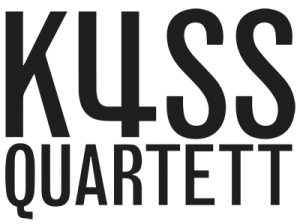Projects
Guides to Reality
“Guides to Reality (AT)”: an immersive event that combines music theater, radio play, game and scripted reality.
In this 70-minute piece, the Kuss Quartet and Sarah Maria Sun perform, supported by high-quality silent disco headphones and DigitAize fingerboard controllers.
GUIDES TO REALITY turns the concert scenario on its head by introducing a cross-genre format that blurs art forms and detaches string quartet music from its historicity.
The audience experiences a diverse mix of noisy, virtuosic rhythmic textures, electronic soundscapes, podcasts, covers from Nirvana to Enno Poppe and newly sampled string quartet repertoire.
Sarah Maria Sun guides the audience through the performance as an emcee, acting as their subconscious, confidante, enemy and past. Their interactions create intimacy and intrigue as selected audience members participate in the performance. The audience wears wireless headphones that allow them to explore different perspectives and engage with the situation.
The headphones allow them to switch between different channels so that the audience can shape their own experience and listen to secret messages, radio broadcasts or alternative perspectives of the event.
The goal is an interactive journey that pushes the boundaries of live performance and draws the audience into music theater v.2.0.

Sara Glojnaric, composer
©Mateja Vrčković

Sarah Maria Sun, soprano ©Rüdiger Schestag
Kuss@Kokon
Kuss@Kokon was an initiative during the pandemic. We got together as a string quartet with friends and companions who are particularly important to our development, who have had a particular influence on us or who have surprised us. We locked ourselves away in studios with them for several days, and each of us brought our own art form to the table, and we then got to work together.
This means, for example, that we provided a Mendelssohn string quartet movement, played it and it was interrupted by percussion, slam poetry or choreography/ dance.
We didn’t illustrate this movement, but met each other with various disruptive factors or the exact opposite of disruption. That was so much fun and brought us to great ideas, of putting together different modules that we could later combine in concerts or events such as festivals, depending on what was needed.
That’s what I call modules: They are concert parts, show parts that can run simultaneously, on different levels such as inside/outside or consecutively or even spread out in a room — depending on the situation.
Instrumentation & works
Force and Freedom
A Beethoven project: for the 250th anniversary of the composer’s birth, Nico and the Navigators and the Kuss Quartet question the aesthetic and political constraints and freedoms in which Beethoven’s work was created.
“The audience alternately heard excerpts from Beethoven’s string quartets and adaptations of the composer’s song fragments … In combination with dance, songs and quotations, Beethoven’s string quartets appeared in a new light … The breathtaking movements of dancer Kawaguchi illustrated the ambivalence of emotions inherent in the music. In short intervals, despair, hope, lightness and melancholy alternated …
The crowning finale of the performance, the “Great Fugue” Opus 133, in which Beethoven repeatedly explodes the firmly established system of the fugue, was also fitting. The audience was enthusiastic.“
SEBASTIAN JUTISZ / RHEIN-NECKAR-ZEITUNG
More details and photos:
Force & Freedom
Instrumentation & works
Bas Böttcher – Slam Poetry
Yui Kawaguchi – choreography & dance
Ruben Reniers – dance
Johannes Fischer – percussion & composition
Óscar Escudero – Electronics
Kuss Quartett
Enno Poppe (*1969)
“Freizeit” for string quartet (2016), commissioned by the Kuss Quartett
Johann Sebastian Bach (1685–1750)
from: Partita No 2 D Minor for violin solo, BWV 1004 3. Sarabande
Manfred Trojahn (*1949)
from: V. Streichquartett (2018), commissioned by the Kuss Quartett
Molto Adagio
Johannes Julius Fischer (*1981)
Under Ground für amplifiziertes Ölfass und Tamtam (2021)
Helmut Lachenmann (*1935)
Toccatina – Study for solo violin (1986)
Thomas Adès (*1971)
from: Arcadiana for string quartet (1994) VI. O Albion
George Benjamin (*1960)
A Lullaby for Lalit for solo violin (2001) (Viola)
Óscar Escudero (*1992)
POST for string quartet, electronics and audience (2021)
Joseph Haydn (1732–1809)
String Quartet C Major, Op. 20,2 (1772)
Armenian Folk Song, solo cello
Johannes Julius Fischer: Duft
slam poetry, string quartet and percussion (2020)
Felix Mendelssohn-Bartholdy (1809–1847)
from: String Quartet F Minor, Op. 80
2. Allegro assai
Throughout the program, texts by Bas Böttcher appear.
The order of the works will be decided at short notice.
Duration: approx. 90 minutes, no break
Commissioned Works
Music exists in time
– this is important to us in both a literal and universal sense.
We are glad and also proud to be part of this ongoing journey of creativity.
The adventure started 1998 with Jörg Widmann’s first string quartet. As winners of the Karl Klingler Competition, we received a special prize for his work and performed it for the first time in Berlin.
We currently receive funding from the state of Lower Saxony in order to kindle new initiatives for string quartet.
An exciting part of our quartet life!

Francisco Coll: Códices
Premiere: 31.10.2023, Stadtcasino Basel
Duration: 15 minutes
Commissioned for the Kuss Quartet by Kammermusik Basel, Konzerthaus Berlin, Wigmore Hall, Het Concertgebouw, and Musik 21 Niedersachsen
Mark Andre: Sieben Stücke für Streichquartett
Premiere: 02.08.2022, Sommerliche Musiktage Hitzacker
Duration: 16 minutes
Iris ter Schiphorst: “Sei gutes Muts”
Premiere: 02.08.2021, Sommerliche Musiktage Hitzacker
Duration: 12 minutes
with Maurice Steger, recorder
Bruno Mantovani: Beethoveniana
Premiere: 16.06.2019, Suntory Hall Tokyo
Duration: 11 minutes
Co-commissioned by: Suntory Hall Tokyo, Philharmonie de Paris, ProQuartet Paris, Musik21 Niedersachsen Hannover,
Concertgebouw Amsterdam & Wigmore Hall London
Aribert Reimann: “Die schönen Augen der Frühlingsnacht”
Premiere: 14.12.2017, Muziekgebouw aan’t IJ Amsterdam
Duration: 9 minutes
with Mojca Erdmann, soprano
Co-commissioned by the Frankfurt Bürgerstiftung in the Holzhausenschlösschen, financed by the Ernst von Siemens Music Foundation
Enno Poppe: Freizeit
Premiere: 30.11.2016, Hannover
Duration: 5 minutes

